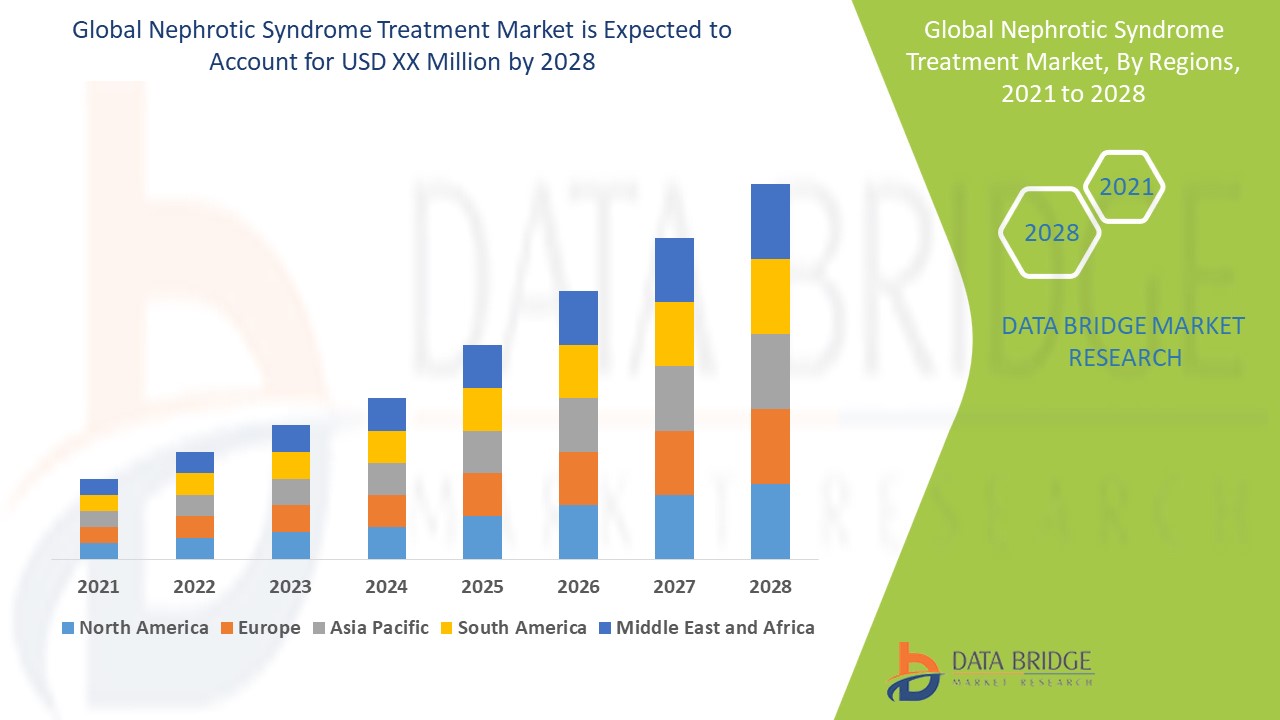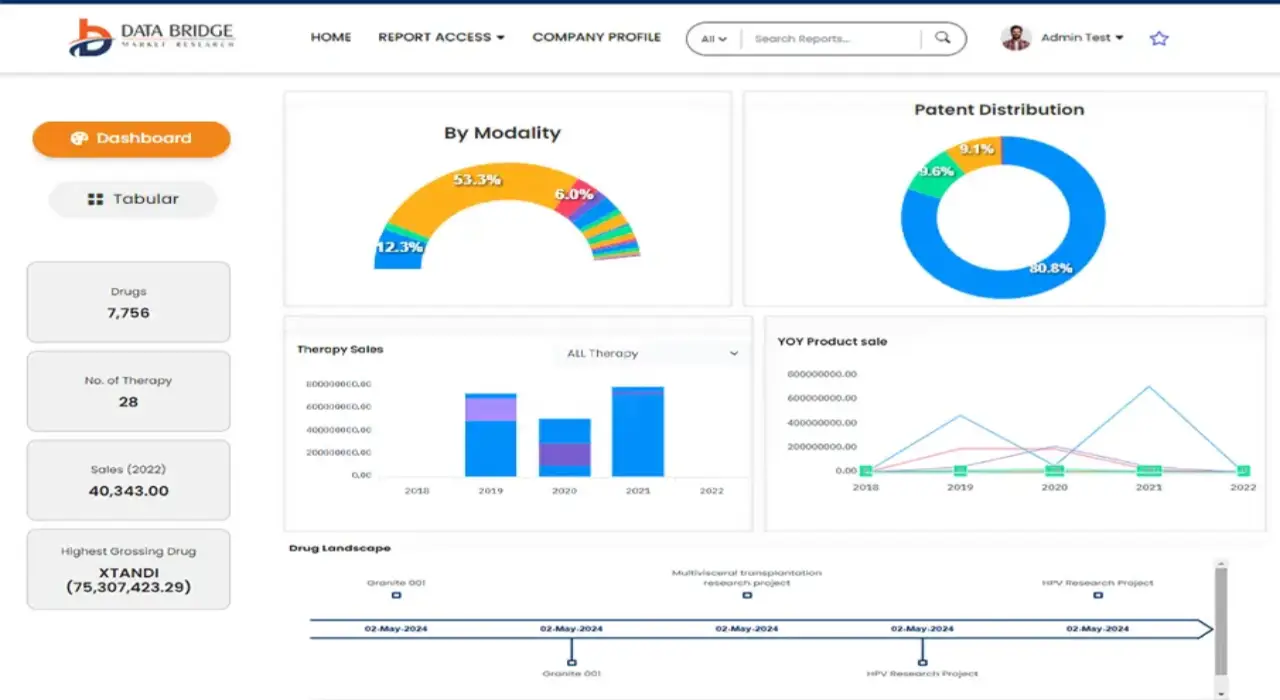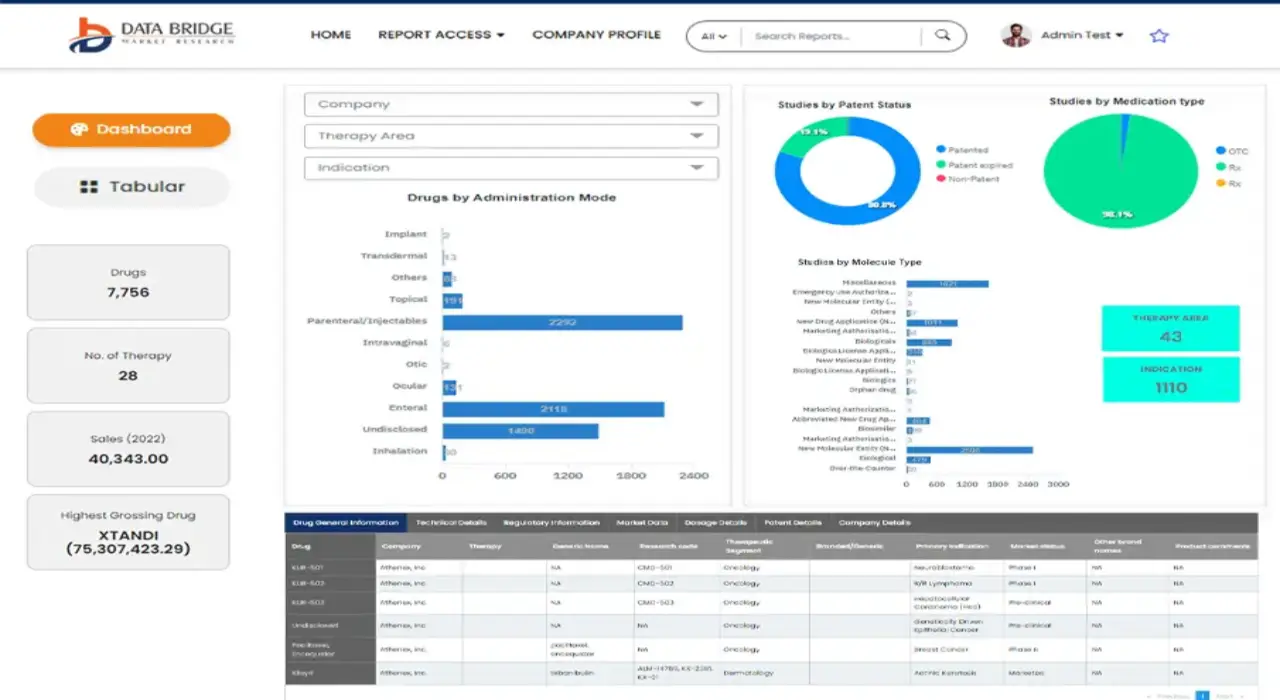Global Nephrotic Syndrome Treatment Market
Market Size in USD Billion
CAGR :
% 
 USD
2.71 Billion
USD
5.44 Billion
2024
2032
USD
2.71 Billion
USD
5.44 Billion
2024
2032
| 2025 –2032 | |
| USD 2.71 Billion | |
| USD 5.44 Billion | |
|
|
|
|
Global Nephrotic Syndrome Treatment Market Segmentation, By Drugs (Sodium Restriction Drugs, Fluid Restriction Drugs, Loop Diuretics, Angiotensin-Converting Enzyme Inhibitor, and Others), End User (Hospitals, Ambulatory Surgical Centres, Specialty Clinics, and Others), Distribution Channel (Hospital Pharmacy, Online Pharmacy and Retail Pharmacy) – Industry Trends and Forecast to 2032
Nephrotic Syndrome Treatment Market Analysis
The nephrotic syndrome treatment market focuses on therapies targeting kidney disorders characterized by excessive protein excretion in urine. This condition is managed through a combination of corticosteroids, immunosuppressants, diuretics, and angiotensin-converting enzyme inhibitors, among others. The growing prevalence of nephrotic syndrome, particularly among pediatric and geriatric populations, fuels market expansion. Innovations in biologics and precision medicines are driving advancements, alongside increasing awareness about early diagnosis and treatment. Recent developments include the introduction of targeted therapies such as rituximab and advancements in drug delivery systems for improved efficacy. Companies such as Pfizer, Novartis, and Aurinia Pharmaceuticals are actively engaged in research and strategic collaborations to expand treatment options. In addition, the shift towards personalized medicine and patient-centric approaches is reshaping the market dynamics. With rising healthcare investments and an emphasis on improving renal care infrastructure, the market is expected to witness significant growth in the coming years.
Nephrotic Syndrome Treatment Market Size
The global nephrotic syndrome treatment market size was valued at USD 2.71 billion in 2024 and is projected to reach USD 5.44 billion by 2032, with a CAGR of 9.32% during the forecast period of 2025 to 2032. In addition to the insights on market scenarios such as market value, growth rate, segmentation, geographical coverage, and major players, the market reports curated by the Data Bridge Market Research also include depth expert analysis, patient epidemiology, pipeline analysis, pricing analysis, and regulatory framework.
Nephrotic Syndrome Treatment Market Trends
“Advancements in Precision Medicine”
The nephrotic syndrome treatment market is evolving with advancements in precision medicine and patient-focused therapies. Characterized by kidney disorders leading to significant protein loss in urine, this market is driven by rising incidences in pediatric and geriatric populations. Innovations such as biologics, including rituximab, and improved drug formulations are enhancing treatment outcomes and minimizing side effects. A key trend is the increasing adoption of personalized medicine, enabling tailored therapies based on genetic and molecular profiles. Pharmaceutical companies are focusing on targeted treatments and collaborations to expand their portfolios. With growing awareness about early diagnosis and a surge in healthcare investments, the market is poised for significant growth, emphasizing better patient care and innovative therapeutic approaches.
Report Scope and Nephrotic Syndrome Treatment Market Segmentation
|
Attributes |
Nephrotic Syndrome Treatment Key Market Insights |
|
Segments Covered |
|
|
Countries Covered |
U.S., Canada and Mexico in North America, Germany, France, U.K., Netherlands, Switzerland, Belgium, Russia, Italy, Spain, Turkey, Rest of Europe in Europe, China, Japan, India, South Korea, Singapore, Malaysia, Australia, Thailand, Indonesia, Philippines, Rest of Asia-Pacific (APAC) in the Asia-Pacific (APAC), Saudi Arabia, U.A.E., South Africa, Egypt, Israel, Rest of Middle East and Africa (MEA) as a part of Middle East and Africa (MEA), Brazil, Argentina and Rest of South America as part of South America. |
|
Key Market Players |
Abbott (U.S.), Asahi Kasei Pharma Corporation (Japan), Bristol-Myers Squibb Company (U.S.), Frederick Furness Publishing (U.S.), Aurinia Pharmaceuticals Inc. (Canada), Pfizer Inc. (U.S.), Mallinckrodt (U.K.), Novartis AG (Switzerland), Travere Therapeutics, Inc. (U.S.) |
|
Market Opportunities |
|
|
Value Added Data Infosets |
In addition to the insights on market scenarios such as market value, growth rate, segmentation, geographical coverage, and major players, the market reports curated by the Data Bridge Market Research also include depth expert analysis, patient epidemiology, pipeline analysis, pricing analysis, and regulatory framework. |
Nephrotic Syndrome Treatment Market Definition
Nephrotic syndrome treatment refers to the medical management of a kidney disorder characterized by excessive protein loss in urine, swelling (edema), low blood protein levels, and high cholesterol. The treatment aims to control symptoms, address underlying causes, and prevent complications. Common approaches include corticosteroids to reduce inflammation, immunosuppressants to manage immune-related triggers, diuretics to alleviate swelling, and angiotensin-converting enzyme inhibitors to protect kidney function. Lifestyle changes, dietary modifications, and supportive care are also integral to managing the condition effectively.
Nephrotic Syndrome Treatment Market Dynamics
Drivers
- Rising Prevalence of Nephrotic Syndrome
The rising prevalence of nephrotic syndrome, particularly among pediatric and elderly populations, serves as a significant driver for the treatment market. Children are more prone to minimal change disease, a common cause of nephrotic syndrome, while the elderly often experience secondary nephrotic syndrome due to underlying conditions such as diabetes or hypertension. This growing patient pool has heightened the demand for effective and targeted therapies. In addition, the need for age-appropriate treatments and long-term management solutions has encouraged pharmaceutical companies to innovate. As awareness and diagnosis rates improve, this demographic trend continues to propel the development and adoption of advanced treatments.
- Advancements in Biologic Therapies
The introduction of targeted biologics, such as rituximab, is revolutionizing the nephrotic syndrome treatment landscape, making it a key market driver. Unlike traditional therapies, biologics offer precision by targeting specific immune pathways implicated in the disease, thereby improving treatment efficacy and reducing side effects. Rituximab, for instance, is particularly effective in managing steroid-resistant and frequently relapsing nephrotic syndrome, addressing unmet clinical needs. Its ability to modulate immune responses has expanded its adoption among healthcare providers. With ongoing research and approvals for advanced biologics, this innovation improves patient outcomes and drives market growth by meeting the demand for sophisticated therapies.
Opportunities
- Rising Demand in Emerging Markets
The growing healthcare infrastructure and increasing awareness in developing countries present a significant opportunity for the nephrotic syndrome treatment market. As these regions improve their healthcare systems, there is greater access to diagnostic tools, specialized care, and treatment options for nephrotic syndrome. Public health initiatives and educational programs are driving awareness of kidney disorders, leading to earlier diagnoses and better management of the disease. This growing awareness, coupled with improved healthcare facilities, creates a larger patient base, making these regions attractive for pharmaceutical companies. With increased government investments, the market is poised for rapid expansion in emerging economies.
- Telemedicine and Digital Health Integration
The adoption of telemedicine for monitoring and managing nephrotic syndrome presents a valuable market opportunity by enhancing patient access to care. Telemedicine allows patients, particularly those in remote or underserved areas, to consult specialists, receive timely diagnoses, and follow-up on treatment plans without needing to visit healthcare facilities. This digital approach improves patient convenience and reduces the burden on healthcare systems. In addition, telemedicine supports continuous monitoring of kidney function and treatment adherence, ensuring better disease management. As healthcare providers increasingly embrace digital health solutions, the nephrotic syndrome treatment market benefits from expanded patient reach and improved outcomes.
Restraints/Challenges
- Limited Treatment Options for Certain Types
Some forms of nephrotic syndrome, such as steroid-resistant and frequently relapsing cases, present a significant challenge in the treatment landscape due to limited effective therapies. While corticosteroids and immunosuppressants are commonly used, they are often ineffective in managing these specific forms of the disease, leaving patients with fewer options. This gap in treatment options complicates disease management and affects patient outcomes. Furthermore, the lack of approved and targeted therapies for these difficult-to-treat cases hinders market growth and innovation. Pharmaceutical companies are focusing on addressing this unmet need, but it remains a key challenge for the nephrotic syndrome treatment market.
- High Treatment Costs
The high cost of advanced therapies, particularly biologics and immunosuppressants, presents a significant barrier for patients, especially in low-income regions. These treatments, while effective, are often priced beyond the reach of many patients, leading to disparities in access to care. The financial burden can result in treatment delays, non-adherence, or the inability to access life-saving medications altogether. This issue is particularly prevalent in developing countries with limited healthcare budgets and insurance coverage. As a result, despite the availability of innovative therapies, the high cost remains a major restraint for the global nephrotic syndrome treatment market.
This market report provides details of new recent developments, trade regulations, import-export analysis, production analysis, value chain optimization, market share, impact of domestic and localized market players, analyses opportunities in terms of emerging revenue pockets, changes in market regulations, strategic market growth analysis, market size, category market growths, application niches and dominance, product approvals, product launches, geographic expansions, technological innovations in the market. To gain more info on the market contact Data Bridge Market Research for an Analyst Brief, our team will help you take an informed market decision to achieve market growth.
Nephrotic Syndrome Treatment Market Scope
The market is segmented on the basis of drugs, end user, and distribution channel. The growth amongst these segments will help you analyse meagre growth segments in the industries and provide the users with a valuable market overview and market insights to help them make strategic decisions for identifying core market applications.
Drugs
- Sodium restriction drugs
- Fluid restriction drugs
- Loop diuretics
- Angiotensin-converting enzyme inhibitors
- Others
End User
- Hospitals
- Ambulatory surgical centers
- Specialty clinics
- Others
Distribution Channel
- Hospital pharmacy
- Online pharmacy
- Retail pharmacy
Nephrotic Syndrome Treatment Market Regional Analysis
The market is analysed and market size insights and trends are provided by country, drugs, end user, and distribution channel as referenced above.
The countries covered in the market report are U.S., Canada and Mexico in North America, Germany, France, U.K., Netherlands, Switzerland, Belgium, Russia, Italy, Spain, Turkey, Rest of Europe in Europe, China, Japan, India, South Korea, Singapore, Malaysia, Australia, Thailand, Indonesia, Philippines, Rest of Asia-Pacific (APAC) in the Asia-Pacific (APAC), Saudi Arabia, U.A.E., South Africa, Egypt, Israel, Rest of Middle East and Africa (MEA) as a part of Middle East and Africa (MEA), Brazil, Argentina and Rest of South America as part of South America.
North America dominate the largest market share due to the rising prevalence and incidence of nephrotic syndrome, particularly among infants. Increased awareness about the risk factors contributing to the condition has further driven market growth. In addition, improved healthcare infrastructure and access to advanced treatments have supported the region's dominant position in the market.
Asia Pacific is the fastest growing region in the nephrotic syndrome treatment market in the coming years, driven by a steady rise in the prevalence and incidence of diabetes. The growing patient population in the region, coupled with an increasing burden of kidney-related diseases, further contributes to this trend. In addition, improving healthcare access and rising awareness are expected to fuel market expansion in the region.
The country section of the report also provides individual market impacting factors and changes in regulation in the market domestically that impacts the current and future trends of the market. Data points such as down-stream and upstream value chain analysis, technical trends and porter's five forces analysis, case studies are some of the pointers used to forecast the market scenario for individual countries. Also, the presence and availability of global brands and their challenges faced due to large or scarce competition from local and domestic brands, impact of domestic tariffs and trade routes are considered while providing forecast analysis of the country data.
Nephrotic Syndrome Treatment Market Share
The market competitive landscape provides details by competitor. Details included are company overview, company financials, revenue generated, market potential, investment in research and development, new market initiatives, global presence, production sites and facilities, production capacities, company strengths and weaknesses, product launch, product width and breadth, application dominance. The above data points provided are only related to the companies' focus related to market.
Nephrotic Syndrome Treatment Market Leaders Operating in the Market Are:
- Abbott (U.S.)
- Asahi Kasei Pharma Corporation (Japan)
- Bristol-Myers Squibb Company (U.S.)
- Frederick Furness Publishing (U.S.)
- Aurinia Pharmaceuticals Inc. (Canada)
- Pfizer Inc. (U.S.)
- Mallinckrodt (U.K.)
- Novartis AG (Switzerland)
- Travere Therapeutics, Inc. (U.S.)
SKU-
Get online access to the report on the World's First Market Intelligence Cloud
- Interactive Data Analysis Dashboard
- Company Analysis Dashboard for high growth potential opportunities
- Research Analyst Access for customization & queries
- Competitor Analysis with Interactive dashboard
- Latest News, Updates & Trend analysis
- Harness the Power of Benchmark Analysis for Comprehensive Competitor Tracking
Research Methodology
Data collection and base year analysis are done using data collection modules with large sample sizes. The stage includes obtaining market information or related data through various sources and strategies. It includes examining and planning all the data acquired from the past in advance. It likewise envelops the examination of information inconsistencies seen across different information sources. The market data is analysed and estimated using market statistical and coherent models. Also, market share analysis and key trend analysis are the major success factors in the market report. To know more, please request an analyst call or drop down your inquiry.
The key research methodology used by DBMR research team is data triangulation which involves data mining, analysis of the impact of data variables on the market and primary (industry expert) validation. Data models include Vendor Positioning Grid, Market Time Line Analysis, Market Overview and Guide, Company Positioning Grid, Patent Analysis, Pricing Analysis, Company Market Share Analysis, Standards of Measurement, Global versus Regional and Vendor Share Analysis. To know more about the research methodology, drop in an inquiry to speak to our industry experts.
Customization Available
Data Bridge Market Research is a leader in advanced formative research. We take pride in servicing our existing and new customers with data and analysis that match and suits their goal. The report can be customized to include price trend analysis of target brands understanding the market for additional countries (ask for the list of countries), clinical trial results data, literature review, refurbished market and product base analysis. Market analysis of target competitors can be analyzed from technology-based analysis to market portfolio strategies. We can add as many competitors that you require data about in the format and data style you are looking for. Our team of analysts can also provide you data in crude raw excel files pivot tables (Fact book) or can assist you in creating presentations from the data sets available in the report.













